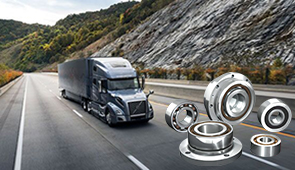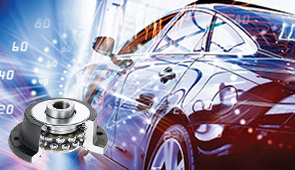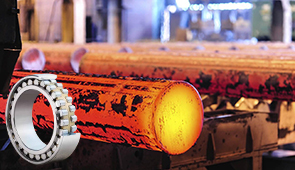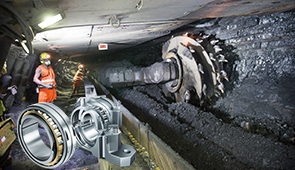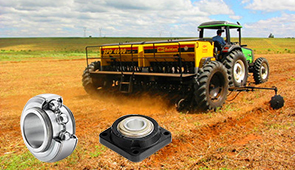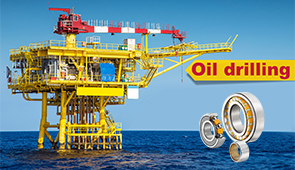Understanding Bearings: A Comprehensive Guide to Types and Applications
Bearings are fundamental components that play a pivotal role in countless mechanical systems. From enabling the smooth operation of machinery to ensuring efficiency and longevity in industrial applications, bearings are integral to modern engineering and design. But what exactly are bearings, and how do they work? This guide aims to break down the complexities of bearings, exploring their various types, functions, and the critical applications they serve. Whether you’re a seasoned engineer, a curious enthusiast, or a professional seeking reliable insights, this comprehensive article will provide the technical knowledge and practical applications you need to understand these crucial mechanisms.
What is a Bearing and How Does it Work?
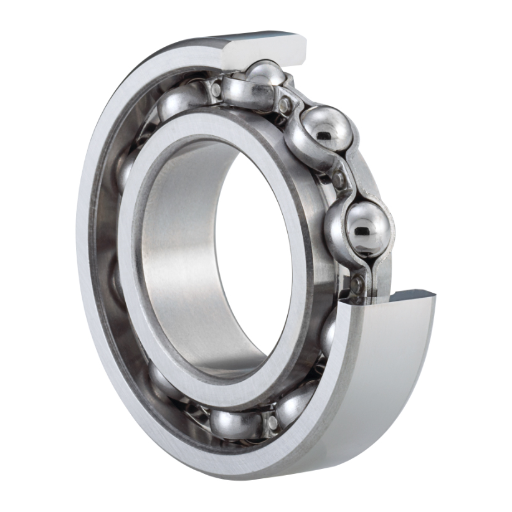
Key Functions of a Bearing
Bearings play a very important role in mechanical systems because they facilitate controlled movement between parts of a system while managing friction. They mainly serve to provide support to rotatable and movable elements such as shafts, thereby guaranteeing smooth and consistent motion. Bearings make machinery much more efficient by lowering the amount of energy expended during tasks and the amount of wear suffered by the components in use.
Another important purpose of a bearing is to carry loads and distribute them. Bearings have to bear the radial loads that are applied perpendicularly to the rotational axis, but also to support axial loads that are parallel to the axis of rotation. They make sure that machines stay operational under a vast class of conditions without risking performance or safety by having the ability to withstand different kinds of loads.
Bearings also maintain system alignment. They allow for keeping precise positioning of the parts that are in relative motion with each other, so that any undesired movement that may cause some alignment problems does not occur. That degree of accuracy is especially important for high-speed or high-precision tasks in the fields of automotive and aerospace, and industrial machines.
How Bearings Reduce Friction in Machinery
Bearings help in minimizing friction in a machine as they are able to separate its moving parts, thus decreasing contact between surfaces. Bearings contain rolling elements that include balls and rollers, which replace sliding friction with rolling friction, which is less forceful. Friction not only lowers the efficiency of a machine but also increases the wear and tear of mechanical parts, thus shortening their life span.
The smooth and hard surface of the bearing materials assists in minimizing friction, which is mostly made of steel or ceramic. These materials endure high levels of stress and work under different loads seamlessly. Bearings are also lubricated with oils or grease, which further lessens the friction caused as lubrication forms a thin film that separates surfaces and lowers the heat produced through friction.
Bearings enable forces to be evenly applied across the rotating components, which avoids alignment issues. This formation helps in avoiding structural degradation or localized harm from uneven pressure. Through the effective optimization of friction, bearings help to sustain energy efficiency, reduce power usage, and ensure the functionality of machines in various industries.
The Role of Inner and Outer Rings in Bearings
The inner and outer rings of a bearing are the main parts that support the functioning of the bearing itself under dynamic or static loads. The shaft transmits the motions and loads to the rolling elements through the inner ring, which is mounted on a rotating shaft. On the other hand, outer rolling elements have to be joined to a housing, and that gives the shaft stability, meaning heat and friction can be generated whilst the structural comfort of the bearing shaft is being bent and meshed.
Both of these devices take a lot of stress, wear and tear, and mellow motion fatigue, which is uncommon in most designs. This means that the components have to be meticulously crafted, which in turn means spending money on high-grade hardened steel. Friction and heat in operations arise through complicated and precise movement that involves smooth and intricate mechanisms. Inner ring and outer grooves provide propulsion and retaining slides through rings, thus making work greatly easier. By doing so, the risk of components misaligning or creating bizarre movements alongside prompt spirals of eaten mesh is reduced, scattering the bearing’s life across the jaws of.
Moreover, the inner and outer rings help in the equal distribution of loads across the bearing parts. This balanced load distribution is important for the optimal operation in high-speed or high-load scenarios. The inner and outer rings, along with other bearing parts, provide dependability and strength amid changing operational influences throughout industrial machinery, automotive systems, and aerospace tools.
Different Types of Bearings
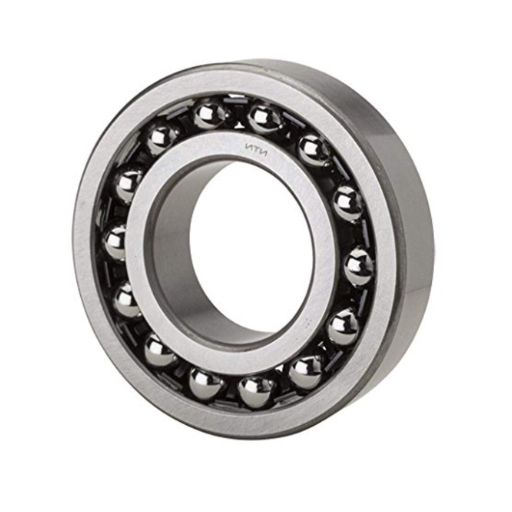
Exploring Ball Bearings and Their Uses
Ball bearings stand out as one of the most frequently operated bearings because of their adaptability and efficiency. Their operation consists of several spherical balls placed between an inner and outer ring, which minimizes friction and aids radial and axial load support. Today, ball bearings are used in different machines across all industries.
- Deep Groove Ball Bearings
Deep groove ball bearings encompass the most popular type of ball bearing in existence. They can manage both radial and axial loads with maximum efficiency. Their simplistic structure, alongside the need for little maintenance, makes them fit for use with electric motors, household devices, and from vehicles to car transmissions. In addition, their long-lasting and high-speed operation attributes are well-known safeguards of these bearings.
- Self-Aligning Ball Bearings
Like the name implies, self-aligning ball bearings include a double-row construction and a spherical outer ring raceway. These self-aligning capabilities assist the accommodating misalignments, making the bearings ideal for challenging applications with alignment restrictions. Some of their most common applications encompass agriculture and textile machines, as well as conveyors where shaft misalignment or non-uniform loads apply.
- Angular Contact Ball Bearings
Angular contact ball bearings are designed to carry high axial loads coupled with radial loads. The raceways are set at an angle concerning the bearing axis, which allows supporting higher levels of precision as well as high-speed operations. Such bearings are widely used in spindles of machine tools, pumps, and high-speed motors.
- Thrust Ball Bearings
Thrust ball bearings are constructed to bear axial loads exclusively. In other words, there is little to no radial load-bearing capacity. They are made up of balls placed between two washers and are used in low-speed devices such as turntables, swivels, and low-speed gearboxes. Their structure allows free axial rotation with a smooth recovery under moderate load conditions.
- Miniature Ball Bearings
Miniature ball bearings are volumetrically small and are used in applications with tight spacing yet demanding high precision. Such bearings are used in medical instruments as well as surgical devices and in electronic appliances and precision equipment. Their dimensions and capacity to bear loads make them ideal for complex physical systems that need ingenious solutions.
Each of the above ball bearings serves a defined function that helps systems to remain efficient, dependable, and durable in varied operational conditions. These selections enable the user to achieve unmatched reliability in specific applications.
Understanding Plain Bearings
Also known as journal or sleeve bearings, plain bearings or basic bearings serve as essential parts of mechanical systems to allow relative motion between two surfaces with good efficiency. They work by preventing friction with rotation or movement via direct surface contact or a thin layer of lubrication by having smooth expanses, either in linear or circular motion. Unlike ball and roller bearings, plain bearings are devoid of any rolling elements, which makes them simpler in design but very useful in applications with high loads and low speeds.
These bearings are not only simple, but they can also be grouped according to their working environment, materials used to construct them, and lubrication needed to operate. For every need, there is a material and bearing that can be applied. For example, bronze, plastic, graphite materials, and metal-polymer composites are an economical choice for plain bearings. PTFE-coated metal bearings are used in aerospace and automotive industries because of their extreme and self-lubricating properties. Furthermore, dry-running bearings are best for applications that require minimal lubrication.
I would note that the optimal performance of plain bearings is strongly impacted by their load capacity, speed, and operating temperature. Reliability and service life can be achieved by proper maintenance, correct lubrication procedures, and precise alignment. Cost-effective solutions stem from selecting appropriate plain bearings for designated systems, achieving a balance between performance and acquisition cost for numerous industrial, automotive, and mechanical applications.
Applications of Bearings in Various Industries
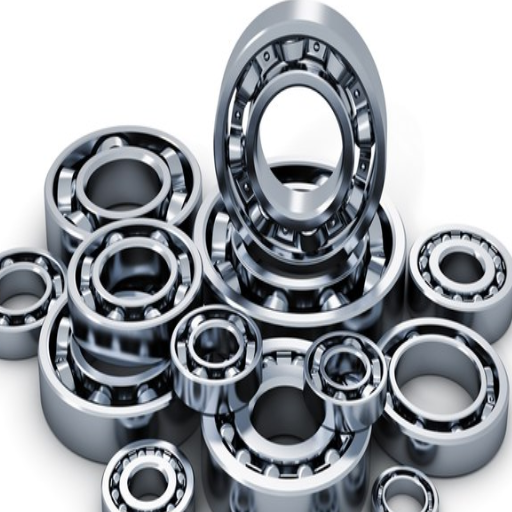
How Bearings are Used in the Automotive Industry
Bearings play a critical role in the automotive sector, where they ensure smooth and efficient operation of numerous mechanical systems.
- Fitment Centres
Bearings are quintessential in the automotive industry as they aid in the successful execution of numerous mechanical tasks. Ultimate performance in both modern and vintage automobiles heavily relies on bearings as they allow for a fluid movement of a vehicle’s wheels, provide the ability to steer, and even help in the acceleration of the automobile. Broadly put, they prevent abrasions and aid friction, subsequently enhancing the effective lifespan of the vehicle.
- Wheel Hubs
Wheel bearing hubs offer support for the wheel’s axle rotation and also bear both radial and axial loads. Most modern cars utilize either a contemporary bearing unit or tapered roller bearings for this function. Advanced (Gen3 and Gen2) integrable units boast superior mechanical characteristics along with simplicity in design that permits uncomplicated repair works, thus becoming more prevalent.
- Engine Components
Nearly all elements of an engine benefit from the inclusion of some sort of bearing, which is included in the crankshaft, camshaft, and connecting rods. Exhaustive ranges of rotary motion are created alongside thrust and journal bearings, which withstand the application of high loads, tremendously high temperatures, and excessive vibrations. A great instance is the extensively used tri-metal engine bearings that are capable of enduring pressures exceeding 100 MPa, which is ideal for high-performance engines.
- Transmission Systems
Bearings like needle roller and ball bearings help facilitate the movement of gears and shafts in rotating machinery. These parts are built for high levels of operation while minimizing energy expenditure due to friction. Studies estimate that using low-friction transmission bearings can lead to a 1.5% improvement in fuel economy, which is invaluable in vehicle construction today.
- Steering Mechanisms
Controls of movement make use of a lot of bearings, like ball thrust bearings, which allow for rotation in two directions while minimizing sliding friction. EPS (Electric Power Steering) systems require advanced bearings that enable precise steering movements and rapid changes, as well as maintain structural integrity over millions of operational cycles.
- Air Conditioning Compressors
Sealed ball bearings enable the quiet turning of the compressor shafts in the air conditioning system of a car. Automotive grade bearings must endure the ultra-high temperature environments, along with continuous operation and refrigerant pressure buildup constantly trying to jam them, to provide the shift in lifespan and functionality of the system into overdrive.
Bearings are an often overlooked but crucial part of the automotive world. Their ability to bear heavy loads, enable motion, and withstand intense stress improves vehicle performance and reliability while increasing efficiency.
The Importance of Bearings in Turbines
Bearings are critical to turbines due to their ability to relieve friction in rotating shafts, enabling the system to operate efficiently and last as long as possible. Bearings give support to wind turbines, allowing them to sustain axial and radial forces caused by the wind while keeping alignment, which greatly increases energy output. Furthermore, modern turbine bearings are constructed to withstand high speeds, pressure, and painful temperature shifts all at the same time.
Turbine applications use spherical roller bearings, cylindrical roller bearings, and tapered roller bearings. Each of them was crafted with a different purpose and performance metrics in mind. Tangentially, spherical roller bearings are crucial components of main shaft systems since they contain alignment slack, but cylindrical roller bearings are best at radial loads during high-speed rotations in gearboxes.
New high-strength alloys and specialized coatings introduced in material science are increasing bearing life and extending maintenance windows. Coupled with turbine systems, predictive maintenance technologies allow for real-time bearing monitoring, enabling proactive attention to wear or irregularities. This method greatly minimizes operational halts while guaranteeing uninterrupted functionality in demanding energy contexts. Thus, it can be advocated that bearings are not mere mechanical parts, but pivots in the control of turbine productivity and the dependable functioning of the entire system.
Common Applications of Bearings in Everyday Machinery
Bearings are crucial parts of machines as they allow movement and simultaneously curb friction between the moving components. Below are five common applications of bearings in everyday machinery:
- Vehicles
Bearings are an important part of many functions performed by a vehicle, which include: wheel hubs, transmissions, and engines. To give an example, wheel bearings enable the wheels to turn without friction, and they have to be able to rotate. Furthermore, engine bearings locate crankshafts, which experience massive forces and experience changes in speed and more. Bearings used in cars are subject to extreme conditions and are meant to rotate up to 10’000 RPM with reliable rotational or radial disturbances.
- Refrigerators
Bearings are heavily relied upon to help devices with smooth operations, like turbines, vacuum cleaners, and even washing machines. In regard to washing machines, drum bearings allow the drum to turn under load during spin cycles, which are often over 1,200 RPM. That is not all, fan bearings from the fridge also help in ensuring that energy consumption is relatively low while the appliance is in operation.
- Commercial Equipment
Bearings are an important part of the entire industrial equipment system, functioning alongside conveyor belts, pumps, and compressors. The Conveyor bearings allow for Impeccable handling of the material alongside the conveyor, which is also sustained by the pump bearings that support high loads so that the fluid transfer systems work with complete fluidity and efficiency, along with the ability to operate for long periods
- Aerospace Applications
Precision aerospace bearings are built to endure the precision and dependability constraints of aircraft engines, landing gears, and navigation systems. For example, thrust bearings in jet engines bear thrust loads while maintaining acceptable temperatures of over 1,000°F (538°C) during stable performance at high-speed operation.
- Electric Motors
Bearings reduce friction while supporting the rotor shaft in electric motors, enhancing motor efficiency and lifespan. Enhanced ball bearings featured in electric motors are capable of attaining efficiency levels of more than 97 percent in both commercial and industrial settings, including HVAC systems and automated systems.
This information highlights the role of bearings in mechanical efficiency, cleanliness, bearing life, and reliability of systems.
Materials and Design of Rolling Element Bearings
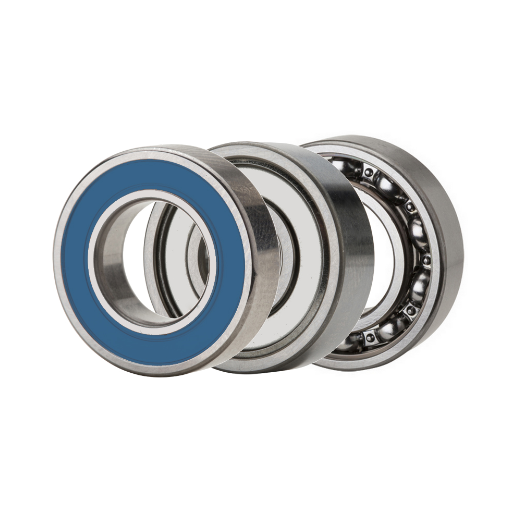
Common Bearing Materials and Their Properties
The performance, reliability, and application suitability of rolling element bearings are affected by the materials comprising them. Rolling element bearing materials include the following:
- Chrome Steel (AISI 52100)
Rolling element bearings utilize chrome steel since it is the easiest to procure and meets the required characteristics. Its wear resistance, fatigue strength, and hardness are best in class. It has about 1% carbon and 1.5% chromium by weight, guaranteeing at least moderate bearing durability. Chrome steel bearings are made for high precision and high-load applications, but cannot be used in corrosive environments unless special coatings are applied chrome coatings.
- Stainless Steel
For use in applications with exposure to moisture, chemicals, or extreme temperatures, stainless steel bearings are the preferred choice due to their high corrosion resistance. These materials possess high chromium alloys, often above 11% chromium concentration, guaranteeing high resistance but weakening oxidation. While proving beneficial in maintaining bearing durability in harsh environments, stainless steel may lower load carrying capacity when compared to chrome steel.
- Ceramic Materials
Silicon nitride (Si3N4) ceramics are being used more and more in hybrid and fully ceramic bearings. These materials have low density, high temperature resistance, and better hardness, wear resistance, and toughness. Ceramic bearings have low friction, thermal expansion, and thrust, which makes them ideal for extreme-speed or temperature applications like aerospace systems or electric motor spindles.
- Polymer and Composite Materials
Polymer bearings reinforced by glass or carbon fiber are used for the most lightweight and low-load applications that require high corrosion resistance and inertness to chemicals. Such bearings are widely used in food processing, medical devices, and other equipment where lubrication-free operation is needed.
Selecting each material will lead to some compromise regarding load-bearing capacity, cost, and resistance to the environment. Most materials need to be tailored according to the set operational which include temperature, load, speed, and contamination.
Innovations in Bearing Design
Recent strides in bearing design have been directed toward improving performance parameters like sustaining, working efficiency, and adaptability to severe working conditions. Ceramic and hybrid ceramic bearings are made with composites that have better thermodynamic properties, lower friction, and longer life of operation as compared to traditional steel bearings. These properties make them suitable for use in aerospace, semiconductor manufacturing, and advanced automotive technologies, which require high precision and high speed.
The advent of smart bearings with fitted sensors capable of measuring temperature, vibration, and load has also catalyzed change in this industry. Data provided by these sensors can be used for predictive maintenance, thereby lowering unexpected downtime. The operational efficiency and the lifecycle of equipment are significantly improved across primary industries.
Additive manufacturing, also referred to as 3D printing, has transformed the bearing fabrication process, which enables the creation of bespoke bearings with high precision. Rapid prototyping for complex designs that are impossible to achieve via conventional methods can be done with ease. This adaptability offers solutions to diverse applications which, previously, would have increased the time taken and resources used in manufacturing while resulting in unnecessary waste.
Lastly, implementing new sophisticated lubrication techniques like solid lubricants, and self-lubricating bearings lessens the requirement for regular upkeep and improves functionality in areas where traditional lubricants may be less effective, like in vacuums or high-temperature places. All of these advancements together showcase an unprecedented bearing design evolution considering industrial advancements that require higher productivity and efficiency.
The Role of Lubricants in Extending Bearing Service Life
Lubricants are essential for increasing the lifespan of bearings. They control friction, reduce bearing wear, and prevent overheating when the machine is operational. Correct application of lubricants is crucial to the efficiency and durability of bearings, hence, lubricants need to be carefully selected in demanding industrial settings with high loads, temperature shifts, vibrations, and tired mechanical parts. Below is a list of five detailed ways that lubricants help to enhance the lifespan of bearings:
- Friction Reduction
Lubricants create a liquid barrier on a molecular level that exists between the rolling elements and the raceways, which results in friction being greatly reduced. Within the realm of specialized equipment that requires high-speed rotation, friction can be reduced by up to 30% using synthetic lubricants, making them more effective than conventional oils.
- Wear Prevention
Direct contact between various parts is eliminated due to relubricating, which results in a significant decline in abrasive and adhesive wear.
- Corrosion Protection
Grease with anti-corrosion additives has proven effectiveness in humid environments. Such lubricants arrest corrosion-causing contaminants like moisture and oxygen from damaging the surfaces of the bearing.
- Heat Dissipation
Heat that is created from friction in a bearing assembly can be dissipated by lubricants. Effective lubricating oils of high-performance grade help prevent thermal expansion of components while also attaining dimensional precision. For instance, tailor-made oil-based lubricants with specific viscosity have been recorded to lower the operational temperatures in overselling applications by 50°F.
- Removal and Prevention of Contaminants
Lubricants can serve as a medium that can contain and carry away solid particles and other contaminants that can infiltrate the bearing housing. A primary bearing scrubber of exceptional filtration, compatible lubricants eliminate particles that are as small as 10 microns for bearing internal surfaces.
The selection and care of the lubrication systems can help the industries achieve the maximum productivity and dependability of a bearing while exposing it to very minimal chances of unplanned downtimes due to bearing failures. These factors illustrate the importance of bearing failures in contemporary engineering applications.
Maintaining and Extending the Service Life of Bearings
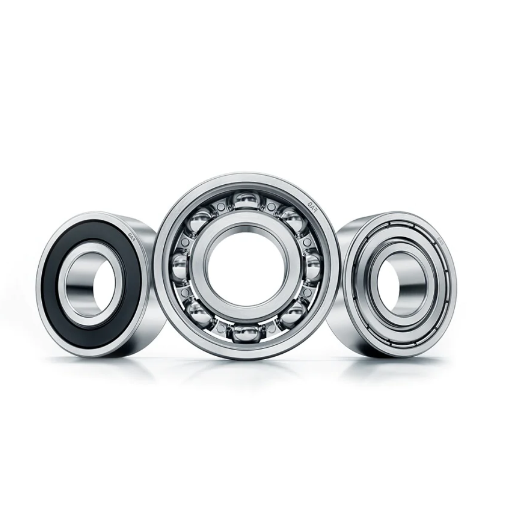
Best Practices for Bearing Maintenance
Appropriate bearing maintenance practices are paramount for acquiring maximum productivity levels in an industrial setting. The following suggestions are meant to assist in accomplishing such goals:
- Monitoring and Inspection Scheduling
Regularly scheduled inspections look for existing damage such as wear, rust, or any signs of bearing contamination. Use thermal imaging and vibration analysis to spot out any performance glitches, abnormalities, or anomalies well within time.
- Management of Lubrication
Establishing a lubrication agenda for specific types of bearings is critical to the area in which the machinery is being used. Important note: lubricants should abide by the standards set in place by the bearings manufacturer. Routinely testing for contamination or degradation needs to be monitored consistently.
- Mitigating Installation and Alignment Oversights
Bearings need to be optimally fitted otherwise, they are susceptible to unplanned failures due to external stress. Fixing a mechanical mounting or hydraulic system eliminates the chances of using improper hand tools. Following the directional outlines ensures precision during alignment, guiding the auxiliary bearings retaining clamps, enabling proper seating along with proper vertical fitting.
- Contamination Control
Maintain operating areas free from contaminants, including dirt, dust, and moisture. Use strong seals and shields to retain bearing assembly kerfs that keep lubricants inside and prevent harmful contaminants outside. Bearings should also be stored and conditioned in climate-controlled rooms to protect them from the environment during handling.
- Load and Environmental Considerations
Ensure no overloading beyond the bearing’s maximum design load and that temperature and humidity fall within specified limits. Work beyond these parameters increases the rate of wear, shortens lifespan, and voids warranty conditions due to accelerated reduction in operational value.
- Proactive Maintenance Schedules
Implement all-inclusive preventive maintenance programs focused on cleaning, re-lubrication, and periodic replacement of critical factors. Employ predictive maintenance technologies to foresee failures driven by real-time data and historical trends.
Following these best practices allows industries to markedly improve bearing reliability and longevity. Condition monitoring solutions combined with unconditional compliance to manufacturers’ guidelines enable relentless performance and cost efficiency associated with downtime and repair.
Signs of Bearing Wear and When to Replace
Identifying the first signs of bearing wear is extremely important to prevent accidents and maintain operational efficiency. Common signs that indicate bearing wear include abnormal noise, excessive vibration, and an increase in temperature. Cylindrical rolling bearings and deep groove ball bearings have elements like spalling and cracks, which cause them to click and grind. Vibration can stem from multiple issues like looseness, imbalance, and misalignment, along with ease and speed of bearing rotation; all these factors increase over time.
Bearing components also demonstrate clear signs of damage like discoloration, lubricant breach, and pitting. Discoloration usually suggests excessive heat along with pitting, which consists of continuous successive impacts in one region. Also known as lubricant failure, grease and debris clog the bearing housing as a result of contamination or breakdown of lubricant, which is another clear, cynical hazard.
Once the indicators listed above are noticed, it is imperative to change the bearings without delay. Not doing so may result in unforeseen equipment breakdowns, which can risk safety, productivity timelines, and repair costs. Superior diagnostics like vibration analysis, ultrasound, and thermal imaging can help determine the exact moment when a bearing is about to exhaust its life. Use of these methods in conjunction with condition-based maintenance techniques makes equipment more dependable while decreasing unexpected downtime.
How Proper Lubrication Affects Bearing Longevity
Having the correct lubricant greatly influences a bearing’s lifespan because it reduces friction, wear, and contamination or corrosion. About 50% of all bearing failures stem from the use of improper lubrication or even a lack of lubricant, the wrong type, or contamination. Effective lubrication minimizes direct contact between machine components, therefore dissipating excessive heat generated during operations.
Determining the right lubricant type is important and depends on the design of the bearing, the operating speed, load, and environmental conditions. For instance, low-drag, less sticky, low-viscosity lubricants are ideal for fast-moving applications, while high-viscosity lubricants that withstand pressure and maintain film strength are preferable in heavy-load environments. Lubricant performance is greatly influenced by temperature as well, since high heat can cause oxidation or a breakdown of lubricant properties, rendering the lubricant ineffective and unable to provide protection.
Scheduled relubrication and monitoring ensure optimal performance and bearing life over time. Lubrication systems with real-time feedback and sensor-based monitoring are capable of accurately dispensing the right volume of lubricant, minimizing the chances of over- and under-lubrication. Enhanced thermal stability and longer intervals between applications from synthetic lubrication mean they are ideal for demanding operations.
Following correct lubrication procedures and using new technologies assists operators in increasing bearing lifespan, conserving energy, and cutting costs for maintenance services.
Frequently Asked Questions (FAQ)
Q: What are the common types of bearings?
A: Bearings are classified into several common types, including ball bearings, roller bearings, needle roller bearings, and fluid bearings. Each type is designed to handle different loads and motion requirements.
Q: How do roller bearings support movement?
A: Roller bearings use cylindrical rollers to maintain the separation between the moving parts of the bearing. They are typically used to support radial loads and facilitate smooth rotation in high-speed applications.
Q: What materials are commonly used in bearings?
A: Bearings are commonly made from materials such as steel, ceramic, and plastic. The choice of material depends on the bearing conditions, such as the load, speed, and environment in which they operate.
Q: How do fluid bearings differ from other bearing types?
A: Fluid bearings use a thin layer of liquid or gas between the bearing surfaces instead of solid contact. This type of bearing is often used in high-speed applications where minimal friction and wear are critical.
Q: What are the applications of needle roller bearings?
A: Needle roller bearings are used to support high radial loads in applications with limited radial space. They are commonly used in automotive components, household appliances, and industrial machinery.
Q: Why are groove bearings important?
A: Groove bearings, such as deep groove ball bearings, are important for their ability to handle both radial and axial loads. They are commonly used in applications requiring a durable and versatile bearing solution.
Q: What are active magnetic bearings, and where are they used?
A: Active magnetic bearings use electromagnetic forces to levitate and support the bearing surfaces without physical contact. They are typically used in applications requiring precise control and low friction, such as in high-speed turbines and compressors.
Q: How does bearing type affect linear motion systems?
A: The type of bearing used in linear motion systems affects the system’s load capacity, speed, and precision. For instance, linear roller bearings are ideal for applications requiring high load capacity and smooth linear motion.
Q: What role do bearings play in household appliances?
A: In household appliances, bearings facilitate smooth operation and reduce wear and tear on moving parts. For example, they are used to support rotating components in washing machines and refrigerators.
Q: Why is it important to choose the right bearing for lower speeds?
A: Choosing the right bearing for lower speeds is crucial to ensure efficiency and longevity. Bearings for lower speeds are typically designed to handle different types of loads and reduce friction to facilitate smooth operation.
UCTH213-40J-300 with Setscrew(inch)
CNSORDERNO: Normal-duty(2)
TOGN: UCTH213-40J-300
SDI: B-R1/8
SD: 2 1/2
UCTH212-39J-300 with Setscrew(inch)
CNSORDERNO: Normal-duty(2)
TOGN: UCTH212-39J-300
SDI: B-R1/8
SD: 2 7/16
UCTH212-38J-300 with Setscrew(inch)
CNSORDERNO: Normal-duty(2)
TOGN: UCTH212-38J-300
SDI: B-R1/8
SD: 2 3/8
UCTH212-36J-300 with Setscrew(inch)
CNSORDERNO: Normal-duty(2)
TOGN: UCTH212-36J-300
SDI: B-R1/8
SD: 2 1/4
UCTH211-35J-300 with Setscrew(inch)
CNSORDERNO: Normal-duty(2)
TOGN: UCTH211-35J-300
SDI: B-R1/8
SD: 2 3/16
UCTH211-34J-300 with Setscrew(inch)
CNSORDERNO: Normal-duty(2)
TOGN: UCTH211-34J-300
SDI: B-R1/8
SD: 2 1/8










